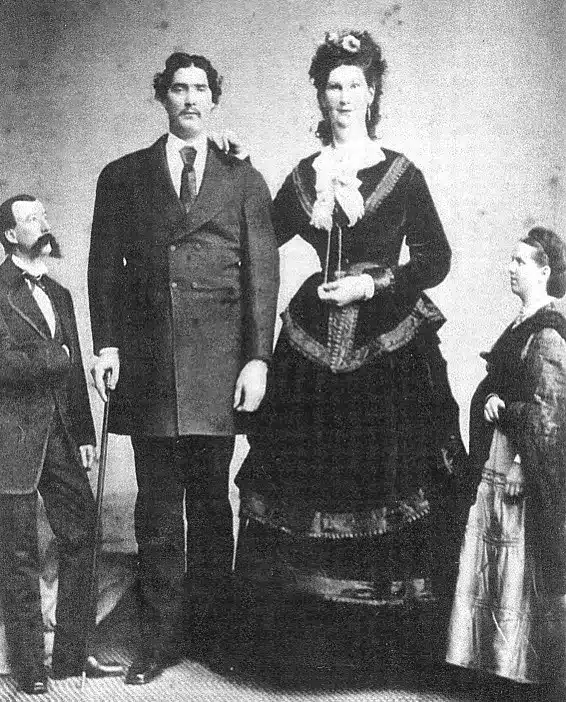Larger than Life: The Tallest and Strongest Civil War Soldiers
Abraham Lincoln visited Niagara Falls in 1848 and was awed by the majestic site. He marveled at the age of the falls in a personal note, writing, “The eyes of that species of extinct giants, whose bones fill the Mounds of America, have gazed on Niagara, as ours do now.”[1] Lincoln concurred with a popular theory of the time that the monumental mounds built by Native Americans in the Midwest could not have been constructed by what was seen as an uncivilized people. Instead, they must have been built by a race of giants. Hoaxes of enormous skeletons seemed to support his conclusion.[2]
Yet flesh-and-blood individuals who we may call giants existed in Lincoln’s day and fought in the Civil War. Two colossal figures served on opposite sides of the conflict, one notable for his height and the other for his Paul Bunyan-like feats of strength.
Martin Van Buren Bates hailed from Kentucky in 1837, a child of normal-sized parents. His growth seemed standard until he reached age seven, when he entered a continuous growth spurt. By twelve, he measured six feet and 200 pounds, and increases to his stature only ceased at twenty-eight, when he was seven feet nine inches tall and almost 500 pounds.[3]
In 1861, Bates entered Confederate service in the 5th Kentucky Infantry. In November 1863 he was attached to the Virginia State Line as a first lieutenant. Soon after, this unit became the Seventh Confederate Cavalry, and Bates became a captain.[4] Allegedly, rumors spread among Union soldiers of “that Confederate Giant who was as big as five men and fights like fifty.”[5] That giant fell wounded around Cumberland Gap and was imprisoned in Ohio’s Camp Chase until hostilities ceased.[6]

After the war, he toured cities across the country. In 1871, he visited England and found a match made in heaven. Anna Swan, towering at seven feet eleven inches, became his bride, and they married in 1871.[7] Queen Victoria herself gave Martin a gold watch, and he came to know Presidents Andrew Garfield and William McKinley.[8] Yet the Bates preferred farming to fame.[9] He and Anna’s two children died in infancy, and Martin outlived his wife by many years. He passed away in 1919 at a ripe old age.[10]
Allen Bradley was born in New York between 1818 and 1821 and moved to Wisconsin in 1855 to work as a lumberjack.[11] Bradley stood “more than six feet tall but he was so broad that he rather looked stocky than tall. He measured more than four feet around the chest, he had hands as broad as shovels and was obliged to wear moccasins because no shoes could be bought that were big enough.” Coupled with this unusual description are Herculean tasks such as carrying a 1000-pound anchor and stacking 300-pound barrels three high for an entire workday.[12]
Bradley enlisted in the 32nd Wisconsin Infantry in 1862, remaining in the ranks until June 1865.[13][14] A county history book from 1917 recounts his capture during an engagement. The Confederates disarmed him and two of their number were tasked with bringing him to the rear while the rest took part in a charge. “No sooner did Bradley find himself alone with his two guards than he suddenly seized them by the neck with a grip of steel in either hand, swung them off their feet, and carried them like two squirming kittens back behind the Federal lines.”[15] After the war, Bradley returned to logging but particularly loved hunting and fishing. He never wore a coat, even in the coldest weather, the chill never seeming to bother him. Alas, he passed away from rheumatism in 1885, possibly a result of his not bundling up for all that time spent in the wilderness.[16]
Bradley’s feats of strength cannot be verified by contemporary reports, but several are attested to by multiple sources during his lifetime. Circus strongmen, whose exhibitions helped shape modern weightlifting, and whose deeds are perhaps the first that can be confirmed, did not begin in earnest until the 1890s.[17] Although Bradley’s tasks range from unlikely to impossible, they are still valuable in what they reveal about the time. In an era where it was thought giants once roamed and information was not as readily available, a lumberjack carrying a thousand-pound anchor does not sound far-fetched.
[1] Abraham Lincoln, “Notes Regarding Niagara Falls” (Notes, 1848). Accessed through https://papersofabrahamlincoln.org/documents/D200527
[2]Robert A. Cook and Bradley T. Lepper, “Uncoiling Serpent Mound’s ‘Slithery Vibe’: Refuting Modern Manifestations of the Moundbuilder Myth,” Journal of Ohio Archaeology 11 (2025): 3-5, 14. https://ohioarchaeology.org/file_download/inline/8c49d928-ac3e-482d-bab1-c43fbc6831a3
[3] “Martin Van Buren Bates,” American Battlefield Trust, accessed Oct. 6, 2025, https://www.battlefields.org/learn/biographies/martin-van-buren-bates
[4] William P. Thayer and James and Karen Macauley, “Captain Bates Autobiography,” Annette Potter Family Genealogy, 2009, https://yeahpot.com/bates/batesmartinautobio.php
[5] Arthur Dixon, “The Giant of the Hills: Martin Van Buren Bates,” Independent Herald (Oneida, TN), Aug 5, 1993. Accessed through https://www.tngenweb.org/scott/fnb_v7n2_martin_van_buren_bates.htm
[6] “Martin Van Buren Bates,” American Battlefield Trust.
[7] “Now a Farmer,” The Courier-Journal (Louisville, KY), Mar. 5, 1896. Accessed through https://www.newspapers.com/article/the-courier-journal-now-a-farmer/3262121/
[8] Dixon, “The Giant of the Hills.”
[9] “Now a Farmer,” The Courier-Journal.
[10] “They Live in the House Giants Built,” The Cincinnati Post (Cincinnati, OH), Apr. 17, 1948. Accessed through https://www.tngenweb.org/scott/fnb_v7n2_the_house_giants_built.htm
[11] “Allen Bradley,” FindaGrave, accessed Oct. 6, 2025, https://www.findagrave.com/memorial/41513256/allen-bradley
[12] Hjalmar R. Holand, History of Door County, Wisconsin, The County Beautiful (Chicago, IL: The S.J. Clarke Publishing Company, 1917), accessed through https://genealogytrails.com/wis/door/history/history1917_chapter38.htm
[13] “Allen Bradley,” The Door County Advocate (Sturgeon Bay, WI), Feb. 19, 1885. Accessed from https://images.findagrave.com/photos/2009/277/41513256_125478865999.jpg
[14] War Department, “Bradley, Allen – 32nd Infantry, Company F,” Accessed from https://dp.la/item/ff344535f3eef2d0a12df62cb5173b16
[15] Holand, History of Door County. https://genealogytrails.com/wis/door/history/history1917_chapter38.htm
[16] “Allen Bradley,” The Door County Advocate.
[17] Jan Todd and Michael Murphy, “The Circus Career of Ottley Russell Coulter, 1912-1916,” Iron Game History 7, no. 1 (Jun 2001): 4. https://starkcenter.org/igh/igh-v7/igh-v7-n1/igh0701c.pdf
Those two must have given their respective quartermasters fits.
Great article! It’s always interesting to read about the cast of characters involved in our Civil War.